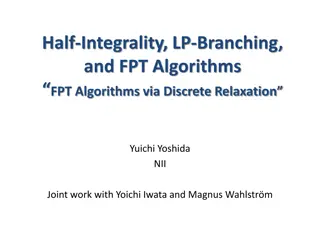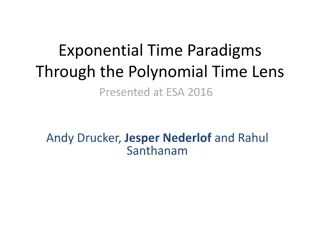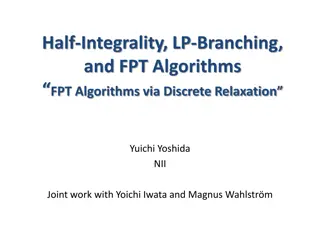
Advanced Topics on Algorithms Exploration by Luciano Gual
Delve into Luciano Gual's insightful guide on parameterized algorithms, exact solutions, and more. Learn about Fixed Parameter Tractability (FPT) problems, k-Vertex Cover, and efficient algorithmic approaches for tackling hard problems.
Download Presentation

Please find below an Image/Link to download the presentation.
The content on the website is provided AS IS for your information and personal use only. It may not be sold, licensed, or shared on other websites without obtaining consent from the author. If you encounter any issues during the download, it is possible that the publisher has removed the file from their server.
You are allowed to download the files provided on this website for personal or commercial use, subject to the condition that they are used lawfully. All files are the property of their respective owners.
The content on the website is provided AS IS for your information and personal use only. It may not be sold, licensed, or shared on other websites without obtaining consent from the author.
E N D
Presentation Transcript
Advanced topics on Algorithms Luciano Gual www.mat.uniroma2.it/~guala/
Parameterized algorithms Episode I (pilot) main reference:
pick any two We would like 1. 2. 3. to solve (NP-)hard problems fast (polynomial time) algorithms to compute exact solutions parameterized algorithms apx algorithms problems in P
idea: aim for exact algorithms, but confine the exponential dependence to a parameter goal: an algorithm whose running time is polynomial in the problem size n and exponential in the parameter exact algorithm running fast provided k is small parameter: k(x) nonnegative integer associated to the instance x parameterized problem: a problem + a parameter we say: problem P w.r.t. parameter k
k-Vertex Cover Input: - - a graph G=(V,E) a nonnegative integer k question: is there a vertex cover S V of size at most |S| k parameter: k example: k can actually be small star graph
Brute-force solution: - - try all O(nk) subsets of k vertices for each subset S: - check whether S is a vertex cover exponent depends on k O(nkm) nf(k) running time: BAD Definition (FPT) A parameterized problem is Fixed Parameter Tractable (FPT) if it can be solved in time f(k) nO(1) independent of n & k any function
Bounded-search tree algorithm: - consider any (uncovered) edge e=(u,v) - either u S or v S (or both) - guess which one: try both possibilities 1. add u to S, delete u and all incident edges from G - recurse on G with k =k-1 2. add v to S, delete v and all incident edges from G - recurse on G with k =k-1 3. - return the OR of the two outcomes - base case: k=0 if there is an (uncovered) edge in G return FALSE, return TRUE otherwise
running time: analysis of the recursion tree n,k - height of the tree k - # of nodes O(2k) - any node costs O(n) k n-1,k-1 n-1,k-1 n-2,k-2 n-2,k-2 n-2,k-2 n-2,k-2 time O(2k n) GOOD FPT algorithm
Toolbox (to show a problem is FPT) bounded-search trees color coding kernelization algebraic techniques iterative compression treewidth
idea: pre-processing an instance in order to simplify it to a much smaller equivalent instance kernelization: a polynomial-time algorithm that converts an instance (x,k) into a small and equivalent instance (x ,k ) kernel equivalent: the answer of (x,k) is the same of the answer of (x ,k ) small: the size of (x ,k ) is f(k) kernelization (x ,k ) (x,k) obs: after you can run every algorithm you want on the kernel
Theorem A parameterized problem is FPT iff it admits a kernelization. proof ( ) kernelize and obtain an instance of size n f(k). run any finite algorithm with running time g(n) on the kernel. Total running time: nO(1)+g(f(k)). ( ) Let A be an f(k)nctime algorithm if n f(k) if f(k) n the instance is already kernelized 1. solve the instance by running A in time f(k)nc nc+1(polynomial) 2. output a O(1)-size YES/NO instance as appropriate (to kernelize)
polynomial kernel for k-Vertex Cover based on reduction rules rule 1: if there is a vertex v of degree k+1, then delete v (and all its incident edges) from G and decrement the parameter k by 1. The new instance is (G-v,k-1) rule 2: if G contains an isolated (0-degree) vertex v, delete v from G. The new instance is (G-v,k) v k+1
polynomial kernel for k-Vertex Cover based on reduction rules rule 1: if there is a vertex v of degree k+1, then delete v (and all its incident edges) from G and decrement the parameter k by 1. The new instance is (G-v,k-1) rule 2: if G contains an isolated (0-degree) vertex v, delete v from G. The new instance is (G-v,k) Lemma If (G,k) is a YES-instance and none of the above rules is applicable to G, then |E(G)| k2and |V(G)| 2k2. proof Since rule 1 is not applicable every vertex has degree k k vertices can cover k2edges Since rule 2 is not applicable, every vertex has an incident edge |V(G)| 2k2 (worst case E(G) is a matching of k2edges)
polynomial kernel for k-Vertex Cover based on reduction rules rule 1: if there is a vertex v of degree k+1, then delete v (and all its incident edges) from G and decrement the parameter k by 1. The new instance is (G-v,k-1) rule 2: if G contains an isolated (0-degree) vertex v, delete v from G. The new instance is (G-v,k) rule 3: let (G, k) be an instance such that rule 1 & 2 are not applicable. If k 0 or G has more than k2edges or more than 2k2vertices, conclude that (G,k) is a NO-instance. Output a canonical NO-instance. running time: naive implementation O(n2) a clever implementation O(n+m) solving k-Vertex Cover: O(n+m+2k k2) kernelization + bound-search tree alg
what can be the parameter k? - - - - - - - - the size k of the solution we are looking for the maximum degree of the input graph the dimension of the point set in the input the length of the strings in the input the length of the clauses in the input Boolean formula the number of moves in a puzzle game the budget in an augmenting problem ...
Examples of NP-hard problems that are FPT: - - - - - - - finding a vertex cover of size k finding a path of length k finding k disjoint triangles drawing a graph in the plane with k edge crossings finding disjoint paths that connects k pairs of vertices finding the maximum clique in a graph of maximum degree k ...
W[1]-hardness Negative evidence similar to NP-completeness. If a problem is W[1]-hard, then the problem is not FPT unless FPT=W[1]. Examples of W[1]-hard problems: - - - - finding a clique/independent set of size k finding a dominating set of size k finding k pairwise disjoint sets given a graph G, finding k vertices that covers at least s edges (partial Vertex Cover) given a Boolean formula, decide if can be satisfied by assigning TRUE to at most k variables ... - -
games to play - The FPT vs W[1]-hardness game - is the problem FPT? The f(k) game for FPT problems - what is the best f(k) dependence on the parameter? The exponent game for W[1]-hard problems - what is the best possible dependence on k in the exponent? - -





